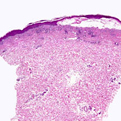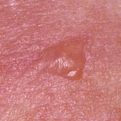Bullous Pemphigoid
General Information
Bullous Pemphigoid is a chronic skin disease characterized by blisters. The blisters usually appear on the flexural areas. A small percentage of individuals may also develop blisters in the mouth or down the throat. The disease is mainly seen in elderly individuals in the fifth through seventh decade of life. Intense pruritus usually accompanies the blisters. The exact cause of the disease is unknown but has been linked to factors including genetics, age, epitope spreading, complement activation and chemokines. Treatment is focused on healing the blisters that exists and decrease the formation of new blisters. Therapy is individualized by patient, keeping in mind preexisting conditions and other specific factors. The most commonly used medications include Anti inflammatory medication and immunosuppressant.
Epidemiology
Uncommon, unknown frequency in the United States
Etiology
Autoimmune disorder; other factors include drugs, mechanical trauma and physical trauma
Pathogenesis
IgG autoantibodies bind to the skin basement membrane
Clinical
Severe blistering of the skin
Histology
Perivascular and interstitial mixed-cell infiltrate in company with edema. The scale-crusts are made up of mounds of parakeratosis that house both plasma and inflammatory cells.
Bibliography
1. “Bullous Pemphigoid” (Online). April 2007 http://www.emedicine.com/derm/topic64.htm (visited: April 1, 2008) 2. “Bullous Pemphigoid” (Online). http://www.aocd.org/skin/dermatologic_diseases/bullous_pemphigoid.html (visited: April 1, 2008)
Download PDF
![]() Bullous Pemphigoid
Bullous Pemphigoid


